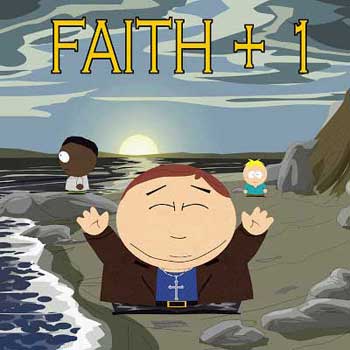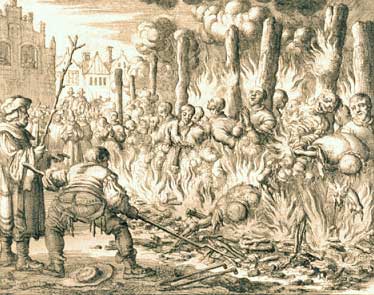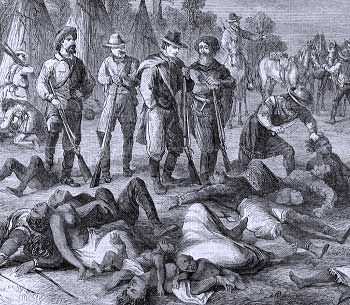
God made it so easy to find the “one true faith” that your parents can pick it out for you even before you are born, and, in most places on earth, they do. Itʼs even easier to find a “true” Christian as opposed to a false one, or a “true” Moslem as opposed to a false one: The “true” believer—the one who understands what their religion "really" teaches, or what their holy book “really” says—always happens to be the one addressing you.
— ETB
Iʼve never understood how God could expect His creatures to pick the one true religion by faith—it strikes me as a sloppy way to run a universe.
— Robert A. Heinlein (Jubal Harshaw in Stranger in a Strange Land)One day a man was asked if there were any true atheists. Do you think, he replied, that there are any true Christians?
— Denis Diderot (1713-1784)
Live long enough and youʼll encounter a lot of folks who say you are not a “true” Christian. Iʼve found the “no-true-Christian-would-do-or-believe-XYZ” game one of the more popular among, well, Christians.
— Jonathan (at the yahoo group ExitFundyism)
Were the Protestant leaders, Martin Luther and John Calvin, “true Christians?” If so, then that proves a “true Christian” can believe that a society in which Christians rule also ought to implement Old Testament laws, because those were revealed by God to be of the greatest satisfaction to Himself and to society. Both Luther and Calvin defended such a view, namely that it was the duty of public rulers and public magistrates to persecute “heretics” as well as exile Jews (or worse if you read what Luther thought ought to be done to them), and execute witches.
— ETB
Christianity Runs the Gamut…
From silent Trappist monks and quiet Quakers — to hell raisers and serpent-handlers;
From those who believe nearly everyone (excepting themselves and their church) will be damned — to those who believe everyone may eventually be saved (“Universalist” Christians);
From those who argue that they are predestined to argue in favor of predestination — to those who argue for free will of their own free will;
From those who argue God is a “Trinity” — to “Unitarian” Christians (which include not only the “Arian” churches of early Christianity, but also modern day Unitarian-Universalist churches, Oneness Pentecostal churches, some modern day Messianic Jewish groups, some primitive Baptist groups, other Jesus-loving sects/cults, and, all of Judaism (which isnʼt “Christian,” but itʼs worth mentioning here that Godʼs chosen people in the earliest “Testament” where taught, “The Lord Your God is One God”);
From those who “hear the Lord” telling them to run for president, seek diamonds and gold (via liaisons with bloody African dictators), or sell “Lake of Galilee” beauty products (see Rev. Pat Robertson) — to those who have visions of Mary, the saints, or experience bleeding stigmata (Catholics);
From those who believe the communion bread and wine remain just that — to those who believe the bread and wine are miraculously transformed into “invisible” flesh and blood (and can vouch for it with miraculous tales of communion wafers turning into human flesh and wine curdling into blood cells during Mass);
From those who believed that priests who delivered communion should never have ever denied their faith in the past even under threat of persecution — to those who believed it did not matter whether or not priests forsook their faith when threatened with persecution (I am speaking of a major controversy in early Christianity between “Donatist” and “Catholic” Christians, both of whom presumed they were the true church on the basis of the division cited above, a division that was never healed, and which ceased only after the North African region where most Donatist churches were located was overrun first by Vandals then later by Muslims.);
From the many Christians that once taught (or teach today as Reconstructionist Christians do) that heretics and apostates ought to be executed — to Albigensian and Cathar Christians who outlawed violence and taught that the shedding of blood and the killing of any living thing, even the slaughtering of a chicken or ensnaring a squirrel, was a mortal sin (a belief they based on the spirituality and metaphors of Christʼs meekness and forgiveness in the Gospel of John). [See The YellowCross: The Story of the Last Catharsʼ Rebellion Against the Inquisition 1290-1329 by René Weis];
From Christians who believe in damning their enemies by calling down Godʼs wrath on them (as in certain imprecatory psalms) and who cite the verse, “an eye for an eye, a tooth for a tooth” — to Amish Christians (among others) who believe in helping the families of those who have offended them. (Case in point, in 2006 a man entered an Amish schoolhouse, gunned down several young female students then shot himself. The Amish later asked what they could do to help the family of the shooter. They planned a horse-and-buggy caravan to visit Charles Carl Robertsʼs family with offers of food and condolences.);
From Christians who view Eastern religious ideas and practices as “Satanic” — to Christian monks and priests who have gained insights into their own faith after dialoguing with Buddhist monks and Hindu priests;
From those who find demons or Satan at work in their fellow Christians and who stress the importance of “deliverance” services — to those who believe demons and Satan were defeated by Jesus when he was enthroned at Godʼs right hand(Preterist inerrantist Christians) and donʼt believe either demons or Satan have power over Christians today — to liberals who donʼt believe in a literal “Satan;”
From those who stress New Testament commands to not judge anyone outside (or inside) the church (depending on the passage of Scripture one reads), who also believe in the blessings of “peacemaking,” who “love enemies” and “control their tongues” that are the “rudders” of their souls, who also believe in following the command to act “meekly” and “humbly” even in the face of curses from others and certain death, and hence who have little difficulty getting along even with those whose beliefs differ radically from their own (1 Peter 2:21-23; 1 Cor. 4:5, 1 Cor. 5:12-13; 2 Cor. 10:1; Matthew 5:5-9, Matthew 5:44; Col. 3:8, Col. 3:17, Col. 4:5-6; James 4:11-12) — to those who believe itʼs best to ridicule and curse “enemies of God,” just as Jesus, Paul, and the prophets once did;
From those who cultivated the castrati (boys in Catholic choirs who underwent castration to retain their high voices) — to the development of Protestant hymns and Gospel quartets — to “Christian rap” and “Christian death metal;”
From those who reject any behavior that even mimics “what homosexuals do” (including a rejection of fellatio and cunnilingus between a husband and wife) — to Christians who accept committed, loving, homosexual relationships (including gay evangelical Church groups like the nationwide Metropolitan Baptist Church);
From Catholic nuns and Amish women who dress to cover their bodies — to Christian nudists (viz., there was a sect known as the “Adamites,” not to mention modern day Christians in Florida with their own nude Christian churches, campgrounds and even an amusement park), and letʼs not forget born-again strippers [click here for more info];
From those who believe that a husband and wife can have sex for pleasure — to those who believe that sex should be primarily for procreation — to those who believe celibacy is superior to marriage (i.e., Catholic priests, monks, nuns, and some Protestant groups like the Shakers who denied themselves sexual pleasure and only maintained their membership by adopting abandoned children until the last Shaker finally died out in the late 1900s) — all the way to those who cut off their genitals for the kingdom of God (the Skoptze, a Russian Christian sect) [click here for more info];
From those who believe sending out missionaries to persuade others to become Christians is essential — to the Anti-Mission Baptists who believe that sending out missionaries and trying to persuade others constitutes a lack of faith and the sin of pride, and that the founding of “extra-congregational missionary organizations” is not Biblical;
From those who believe that the King James Bible is the only inspired translation — to those who believe that no translation is totally inspired, only the original “autographs” were perfect — to those who believe that “perfection” only lay in the “spirit” that inspired the writing of the Bibleʼs books, not in the “letter” of the books themselves;
From those who believe Easter should be celebrated on one date (Roman Catholics) — to those who believe Easter should be celebrated on another date (Eastern Orthodox). And, from those who believe that the Holy Spirit proceeds from the Father and the Son (Roman Catholics) — to those who believe it proceeds from the Father alone (Eastern Orthodox view as taught by the early Church Fathers). Those disagreements, as well as others, sparked the greatest schism of church history (the Schism of 1054) when the uncompromising patriarch of Constantinople, Michael Cerularius, and the envoys of the uncompromising Pope Leo IX, excommunicated each other, thus dividing the Christians of the eastern and western Roman Empire;
From those who worship God on Sunday — to those who worship God on Saturday (Saturday being the Hebrew “sabbath” that God said to “keep holy” according to one of the Ten Commandments) — all the way to those who believe their daily walk with God and love of their fellow man is more important than church attendance;
From those who stress “Godʼs commands” — to those who stress “Godʼs love;”
From those who believe that you need only accept Jesus as your “personal savior” to be saved — to those who believe you must accept Jesus as both savior and “Lord” of your life in order to be saved. (Two major Evangelical Christian seminaries debated this question in the 1970s, and still disagree);
From those who teach that being “baptized with water as an adult believer” is an essential sign of salvation — to those who deny it is;
From those who believe that unbaptized infants who die go straight to hell — to those who deny the (once popular) church doctrine known as “infant damnation.”
From those who teach that “baptism in the Holy Spirit” along with “speaking in tongues” are important signs of salvation — to those who deny they are (some of whom see mental and Satanic delusions in modern day “Spirit baptism” and “tongue-speaking”);
From those who believe that avoiding alcohol, smoking, gambling, dancing, contemporary Christian music, movies, television, long hair (on men), etc., are all important signs of being saved — to those who believe you need only trust in Jesus as your personal savior to be saved;
From those who disagree whether the age of the cosmos should be measured in billions or only thousands of year — whether God pops new creatures into existence or subtly alters old ones — even some who disagree whether the earth goes round the sun or vice versa;
From pro-slavery Christians (there are some today who still remind us that the Bible never said slavery was a “sin”) — to anti-slavery Christians;
From Christians who defend the Biblical idea of having a king (and who oppose democracy as “the meanest and worst of all forms of government” to quote John Winthrop, first governor of the Massachusetts Bay Colony, with whom some Popes agreed, as well as some of todayʼs Protestant Reconstructionist Christians)—to Christians who oppose kingships and support democracies;
From “social Gospel” Christians — to “uncompromised Gospel” Christians;
From Christians who do not believe in sticking their noses in politics — to coup dʼetat Christians;
From “stop the bomb” Christians — to “drop the bomb” Christians;
From Christians who expect in a highly enthusiastic fashion that they could rocket through the air at any moment to be with their Lord — to those with other interpretations concerning such Bible passages.
All in all, Christianity gives Hinduism with its infinite variety of sects and practices a run for its money.
True Christian Quiz!
Determining whether or not you are a true Christian has never been more imperative than today! According to the World Christian Encyclopedia (Oxford University Press, 2001 edition), Christianity now has 150 major ecclesiastical traditions and 33,800 distinct denominations, dioceses, jurisdictions, missions, assemblies, and fellowships. So, the odds that the tradition or denomination you belong to is the “true one” do not look good! Never fear, this simple quiz can help determine whether you are a true Christian. All you need do is “Let your yea be yea, and your nay be nay.”
Do you lead “a sober and upright existence?” (Titus 2:11-13) (Or do you lean a little to the left?)
Are you afraid of being locked out of the heavenly wedding party for being a “foolish virgin?” (Did you ever get a foolish virgin in trouble?)
When Jesus said, “Depart from me you accursed into the hellfire prepared for the devil and his angels,” do you think he was referring to telemarketers, or you?
Do you fear that when Jesus returns he will “spew” you out of his mouth for being “lukewarm?” (Or do you have no fear Jesus will do that to you, since youʼve eaten Mexican your whole life?)
Do you fear “the blood of other people” will be “on your hands” if you donʼt tell everyone about the Gospel? (Alternatively, do you remember to wash your hands every time you leave a Gospel tract in a rest room?)
Are you ever tempted to “love the world?” (How about after swallowing a handful of Viagra?)
Do you ever wonder why killing Godʼs son was not the greatest sin of all? Or wonder how we could be forgiven for that sin, except by killing another savior whose blood must be shed to “atone” for the sin of killing the first one? And so forth and so on…
End of Quiz
Scoring: If you laughed…even once…youʼre damned.
How Have Christians Proven That Their Teachings Are the True Ones?
By the same book they proved that nearly everybody is to be lost, and that all are to be saved; that slavery is a divine institution, and that all men should be free; that polygamy is right, and that no man should have more than one wife; that the powers that be are ordained of God, and that the people have a right to overturn and destroy the powers that be; that all the actions of men were predestined—preordained from eternity, and yet that man is free; that all the heathen will be lost; that all the heathen will be saved; that all men who live according to the light of nature will be damned for their pains; that you must be baptized by sprinkling; that you must be baptized by immersion; that there is no salvation without baptism; that baptism is useless; that you must believe in the Trinity; that it is sufficient to believe in God; that you must believe that a Hebrew peasant was God; that at the same time he was half man, that he was of the blood of David through his supposed father Joseph, who was not his father, and that it is not necessary to believe that Christ was God; that you must believe that the Holy Ghost proceeded; that it makes no difference whether you do or not; that you must keep the Sabbath holy; that Christ taught nothing of the kind; that Christ established a church; that he established no church; that the dead are to be raised; that there is to be no resurrection; that Christ is coming again; that he has made his last visit; that Christ went to hell and preached to the spirits in prison; that he did nothing of the kind; that all the Jews are going to perdition; that they are all going to heaven; that all the miracles described in the Bible were performed; that some of them were not, because they are foolish, childish and idiotic; that all the Bible is inspired; that some of the books are not inspired; that there is to be a general judgment, when the sheep and goats are to be divided; that there never will be any general judgment; that the sacramental bread and wine are changed into the flesh and blood of God and the Trinity; that they are not changed; that God has no flesh or blood; that there is a place called “purgatory;” that there is no such place; that unbaptized infants will be lost; that they will be saved; that we must believe the Apostlesʼ Creed; that the apostles made no creed; that the Holy Ghost was the father of Christ; that Joseph was his father; that the Holy Ghost had the form of a dove; that there is no Holy Ghost; that heretics should be killed; that you must not resist evil; that you should murder unbelievers; that you must love your enemies; that you should take no thought for the morrow, but should be diligent in business; that you should lend to all who ask, and that One who does not provide for his own household is worse than an infidel. [From his Complete Works, Volume 3, About The Bible]
An Exaggerated Command: An Exaggerated Command: “Give To Everyone Who Asks”
[Jesus commanded] Give to him that asketh thee, and from him that would borrow of thee turn not away.
- Matthew 5:42Give to every man that asketh of thee; and of him that taketh away thy goods ask them not again… But love ye your enemies, and do good, and lend, hoping for nothing again; and your reward shall be great, and ye shall be the children of the Highest: for he is kind unto the unthankful and to the evil.
Luke 6:30,35
Next time an evangelical Christian targets you with their soul-seeking missiles, tell them to look up the above verses and read them aloud. After which, ask them for their Bible. If they do not give you their Bible then ask them to please turn to the end of the same sermon in which Jesus spoke the verses above, and read aloud what Jesus said at the very end of that sermon, emphasizing the word “doeth”:
Not every one that saith unto me, Lord, Lord, shall enter into the kingdom of heaven; but he that doeth the will of my Father…Many will say to me in that day, Lord, Lord, have we not prophesied in thy name? and in thy name have cast out devils? and in thy name done many wonderful works? And then will I profess unto them, I never knew you: depart from me, ye that work iniquity. Therefore whosoever heareth these sayings of mine, and doeth them, I will liken him unto a wise man… And every one that heareth these sayings of mine, and doeth them not, shall be likened unto a foolish man.
— Matthew 7:21-24,26
Remind your evangelical friend that if they do not “doeth” what Jesus commandeth them, they risk hearing Jesus say unto them, “Depart from me, ye that work iniquity!” Is that what they want to hear Jesus say to them? Or do they want to give you their Bible, since you asked them for it?
After they have handed it over, tell them, “Thank you,” and say that you donʼt want to keep their Bible forever, nor destroy it. You would just like them to read a few books about the Bible, books that take a more “inquisitive” approach to the Bible and Christianity, like the one on this list [click here]. And then you will return their Bible to them.
Speaking of “giving to all who ask,” hereʼs an idea for the IRS to try. They should print Mat. 5:42 and Luke 6:30 on all tax forms. Beneath the verses should be a little note from the IRS that says, “We ask all Bible believing Christians, especially wealthy televangelists and pastors of mega-churches, to not claim religious tax exemptions this year.”
In fact, I invite everyone to ask their “Bible believing Christian” friends for money every day and keep asking, especially any fat cat Christian ministers they might know. Call their TV stations and radio stations, stand up in their mega-churches, etc., and quote the above verses and ask them for money. There is no limit put on the above commands.





